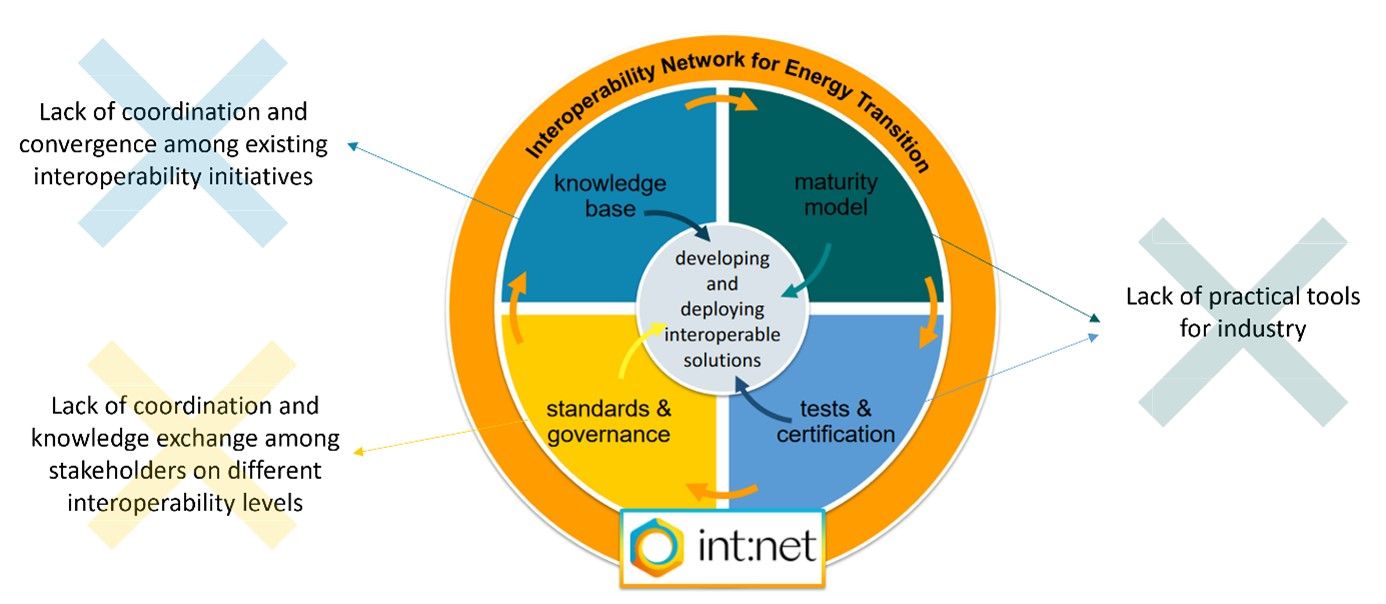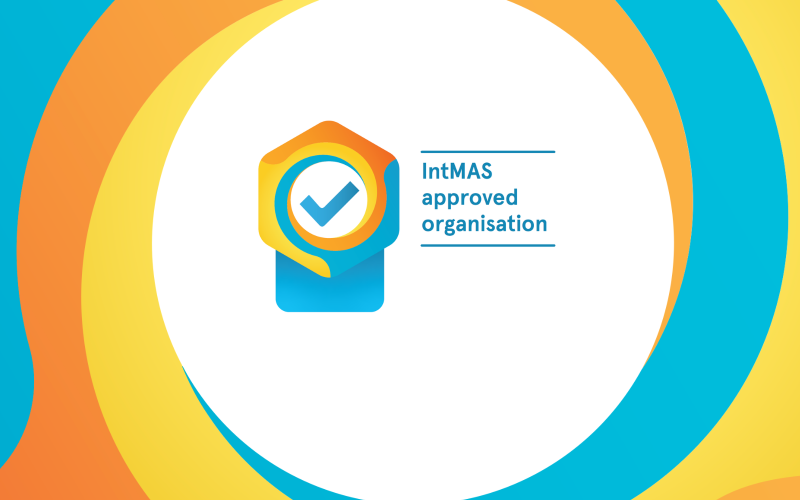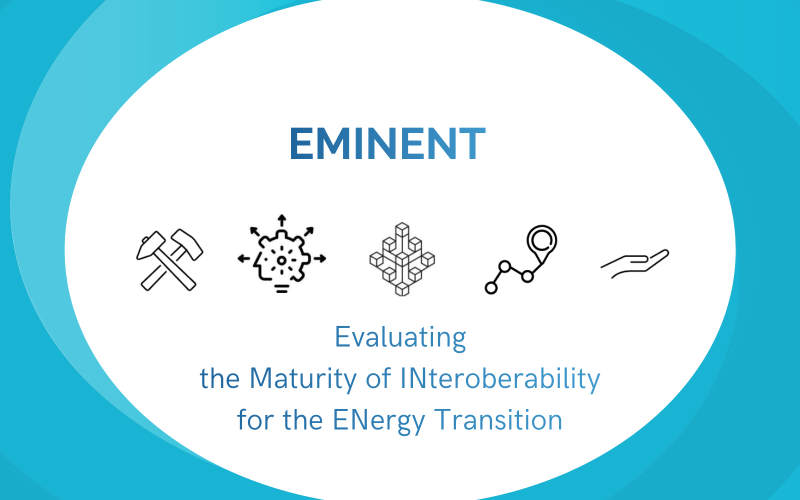int:net at ComForEn Conference 2023
Towards an Interoperability Roadmap for the Energy Transition
12th ComForEn Conference, Vienna / Austria, 16 March 2023
By Valerie Reif (Florence School of Regulation, European University Institute)
int:net is working towards establishing a community of practice to ensure ongoing progress in smart grid interoperability.
From 15-17 March 2023, the int:net project participated in the 12th Symposium Communications for Energy Systems (ComForEn) in Vienna, Austria. During the conference, the project partners held a workshop with stakeholders to discuss the first steps in establishing that community.
Int:net also used the opportunity to present its first ideas of an interoperability roadmap for the energy transition.
The ambition: The twin digital and green transition for Europe
The EU has ambitious climate goals that require a twin digital and green transition of the European economy. This brings new challenges for the energy sector, including
- integrating increasing shares of renewable energy sources,
- leveraging the benefits of an increasingly active demand side,
- deploying a smart digital grid infrastructure, and
- integrating the energy sector with other sectors, in particular buildings and mobility.
The challenge: Interoperability within and beyond the energy sector
There is large consensus that interoperability is one of the means to achieve the transition. Directive (EU) 2019/944 of the Clean Energy Package requires Member States to facilitate the full interoperability of energy services in the EU and the European Commission to define interoperability requirements and procedures for access to metering and consumption data. This effort is ongoing.
The int:net project responded to a Horizon Europe call to build an interoperability community of practice. The community’s objective should be to ensure continuity of the ongoing interoperability of energy services related activities.
In recent years, there have been numerous activities and projects related to smart grid interoperability that int:net can build on. They have produced valuable results, defined important good practices, and contributed to standardisation activities. Nonetheless, smart grid interoperability to date remains heterogenous and fragmented.
The int:net approach: Four cornerstones to address open interoperability issues
Int:net, as a coordination and support action, aims to contribute to reducing this fragmentation and increasing coordination, where needed. Int:net is thus proposing a roadmap based on four cornerstones that address open interoperability issues.

Cornerstone 1: A common knowledge base to facilitate convergence among initiatives
The first open issue to address is a lack of coordination and convergence among the numerous ongoing interoperability initiatives. This is important because uncoordinated action among initiatives can have, sometimes despite the best intentions of the individual initiatives, adverse effects. For example, it can result in
- the existence of several competitive protocols for the same interface, or
- the existence of several competitive tools for the same purpose (e.g., use case repositories).
int:net will establish and maintain a knowledge base of interoperability actions and best practices, which will be more than a mere repository. It will offer its users the option to collaborate. Also, it will not be an additional tool that is competing with the already existing tools, but will be linked to existing platforms, leveraging the work that has already been done by other initiatives.
A first step taken by the project partners was the compilation of a list of interoperability initiatives.
Cornerstone 2: An interoperability maturity model to provide practical tools for industry
The second open issue is a lack of practical tools for the industry. To address this, int:net will develop an interoperability maturity model (IMM), focused on the implementation of interoperability concepts and standards and based on already existing maturity models. This involves the definition of domains and therein specific characteristics that represent different levels of maturity, such as e.g. initiating, enabling, integrating, optimising, and pioneering
Why is this important? An IMM will help organisations to understand their level of maturity in the integration of smart grid technologies, distributed generation and customers with the planning and operation of grids and markets. It will also help the industry highlight gaps or identify priorities for ongoing improvements in interoperability standards and approaches.
Int:net will also develop a reference implementation of the model. This will allow organisations to assess their progress in implementing important interoperability concepts. It will also assist the industry in tracking its progress over time in supporting interoperability for accelerated adoption of new technologies and systems.
Cornerstone 3: A framework for interoperability testing to harmonise existing approaches
Another open issue is related to testing. There are several ways and principles to realise interoperability between two interconnected systems:
- by applying interoperability-by-design,
- by providing reference architectures, or
- by following agreed rules, guidelines, and standards.
Following these principles is not sufficient to ensure interoperability, however. What is needed are corresponding interoperability tests and certificates that provide evidence of these tests. Int:net has identified several open issues in this context. The first is that, currently, testing procedures, categorisation, evaluation, and assessment criteria of the existing interoperability initiatives are diverse and serve a wide range of interests. The second is that, currently, the most advanced testing approaches are typically at component / device level, while those on system level are rather at the research and development stage.
Int:net aims to address these issues by
- providing an overview of the existing interoperability testing approaches in the various smart grid and energy system research infrastructures and laboratories across EU Member States.
- harmonising the existing testing procedures and concepts, to the extent possible.
- ultimately, combining all these testing facilities and certification centres in a pan-European network.
Cornerstone 4: A governance process to bring together all relevant stakeholders
The third open issue is related to the need to bring multiple stakeholders together to develop interoperable solutions. Three elements are of importance.
The first element is related to the multiple layers of interoperability that all need to be addressed in order to develop interoperability solutions. The well-known Smart Grid Architecture Model (SGAM) framework gives a good indication of these layers. However, comparisons with best practices and interoperability frameworks used in other sectors have shown that there may be more dimensions to be addressed. Examples are a legal layer or a governance layer that are currently missing from the SGAM framework.
The second element is related to the actors that are active on the different interoperability layers. They have different interests and are also likely to speak different languages. For example, there are policymakers and regulators active on the highest levels, and system engineers and developers active on the more technical layers. To reach the full interoperability of energy services, all stakeholders have to be included in the discussion. However, for feasibility reasons, a step-by-step approach should be applied; namely identifying the stakeholders relevant for a specific interoperability issue to address, before moving to the next.
The third element is related to the process that brings all these stakeholders together. It should be recurrent and sustainable beyond the lifetime of the int:net project. At the ComForEn conference, the project partners made an important step forward, pinning down a list of stakeholders that need to be addressed, and brainstorming first ideas on how to engage them in a governance process for interoperability.
Beyond the int:net project: Interoperability network for the energy transition
Int:net is different from other research projects. From the very beginning, the project partners are working in two timeframes: within the duration of the int:net project and beyond.
This is because existing experiences with interoperability in the energy and other sectors have shown that reaching and maintaining interoperability is not a one-off task but requires continuous effort. One needs to keep track of changing policies and regulations, emerging new use cases and requirements, and evolving standards, among others. One also needs to make sure that tools and processes are kept up-to-date and fit-for-purpose. This holds true also for the solutions developed and facilitated by the int:net project. To remain relevant, they need to be publicly accessible and stay up-to-date beyond the duration of the research project itself.
Int:net is establishing a community of practice, the interoperability network for the energy transition, that will outlive the research project and continue its main activities. While we do not yet know the exact scope and form of this community, we are committed to making it happen. And we welcome your input!
Are you engaged in an interoperability initiative and want to become part of our community?
Contact us under
Feel free, to download the PDF version of the ppt slides here.
The publication Towards an Interoperability Roadmap for the Energy Transition is now also publically available with those links:
https://arxiv.org/abs/2309.08284v1 or https://link.springer.com/article/10.1007/s00502-023-01144-2




